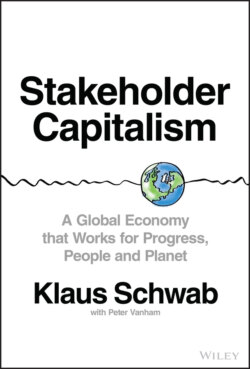Читать книгу Stakeholder Capitalism - Klaus Schwab - Страница 20
Low GDP Growth
ОглавлениеAs we outlined in Chapter 1, the global economy in the last 75 years has known many periods of rapid expansion, as well as some significant recessions. But the global economic expansion that started in 2010 has been tepid. While global growth8 reached peaks of 6 percent and more per year until the early 1970s and still averaged more than 4 percent in the run up to 2008, it has since fallen back to levels of 3 percent or less9 (see Figure 2.1).
The number three matters, because it acted for a long time as a pass-or-fail bar of standard economic theory. Indeed, until about a decade ago, the Wall Street Journal pointed out, “Past IMF chief economists called global growth lower than either 3% or 2.5%—depending on who was the chief economist—a recession.”10 One explanation came from simple math: from the 1950s until the early 1990s, global demographic growth almost consistently lay at 1.5 percent growth per year or higher.11 A global growth rate that was only slightly over the rate of population growth meant large parts of the world population were in effect experiencing zero or negative economic growth. That type of economic environment is discouraging to both workers, companies, and policymakers because it indicates little opportunity for advancement.
Figure 2.1 World GDP Growth Has Been Trending Downward since the 1960s
Source: Redrawn from World Bank GDP growth (annual %), 1960–2019.
Perhaps in response to slowing economic growth, economists have since changed their definition of what constitutes a global recession. But it does not alter the fact we have seen meager global economic growth ever since. As a matter of fact, economic growth of less than 3 percent per year seems to be the new normal. Even before the COVID crisis, the IMF did not expect global GDP growth to return to above the 3 percent threshold for the next half decade,12, 13, 14 and that outlook has been negatively affected by the worst public health crisis in a century.
From the perspective of conventional economic wisdom, this could lead to systemic fault lines, as people got used to economic growth. There are two reasons for that.
First, global GDP growth is an aggregate measure, which hides several national and regional realities that are often less positive still. In Europe, Latin America, and Northern Africa, for example, real growth is edging closer to zero. For Central or Eastern European countries that still have economic catching up to do with their neighbors to the West or North, such low growth is discouraging. It may accelerate the brain drain, as motivated and educated people seek economic opportunities in higher-income countries, thereby exacerbating the problems of their home countries. The same is true in regions like the Middle East, Northern Africa, and Latin America, where many people still don't have a fully middle-class lifestyle and where jobs that offer financial security are lacking, as are social insurance and pensions.
Second, in regions where growth is higher than the average, like in Sub-Saharan Africa, even top-line growth of 3 percent or more per year isn't enough to allow for rapid per capita income growth, given their equally high rate of population growth. Low- and lower-middle-income countries that have posted relatively high growth levels in recent years include Kenya, Ethiopia, Nigeria, and Ghana.15 But even if they were to grow consistently at 5 percent per year for the foreseeable future, it could take an entire generation (15–20 years) for their people's incomes to double. (And that is assuming that most of the fruits of economic growth are shared widely, which often is not the case.)
Rapid progress and shared economic growth, like that seen in China in the early 21st century, require real growth rates of 6 to 8 percent in the least developed economies. Lacking this kind of super boost, the great convergence of economic standards of living between North and South, as predicted by some economists, will materialize very slowly, if at all. As Robin Brooks, chief economist at the Institute of International Finance (IIF) told James Wheatley of the Financial Times in 2019: “More and more, there is a discussion that the growth story for emerging markets is just over. There is no growth premium to be had any more.”16
Looking beyond GDP does not provide more promising prospects. Other economic metrics, notably debt and productivity, are also pointing in the wrong direction.
